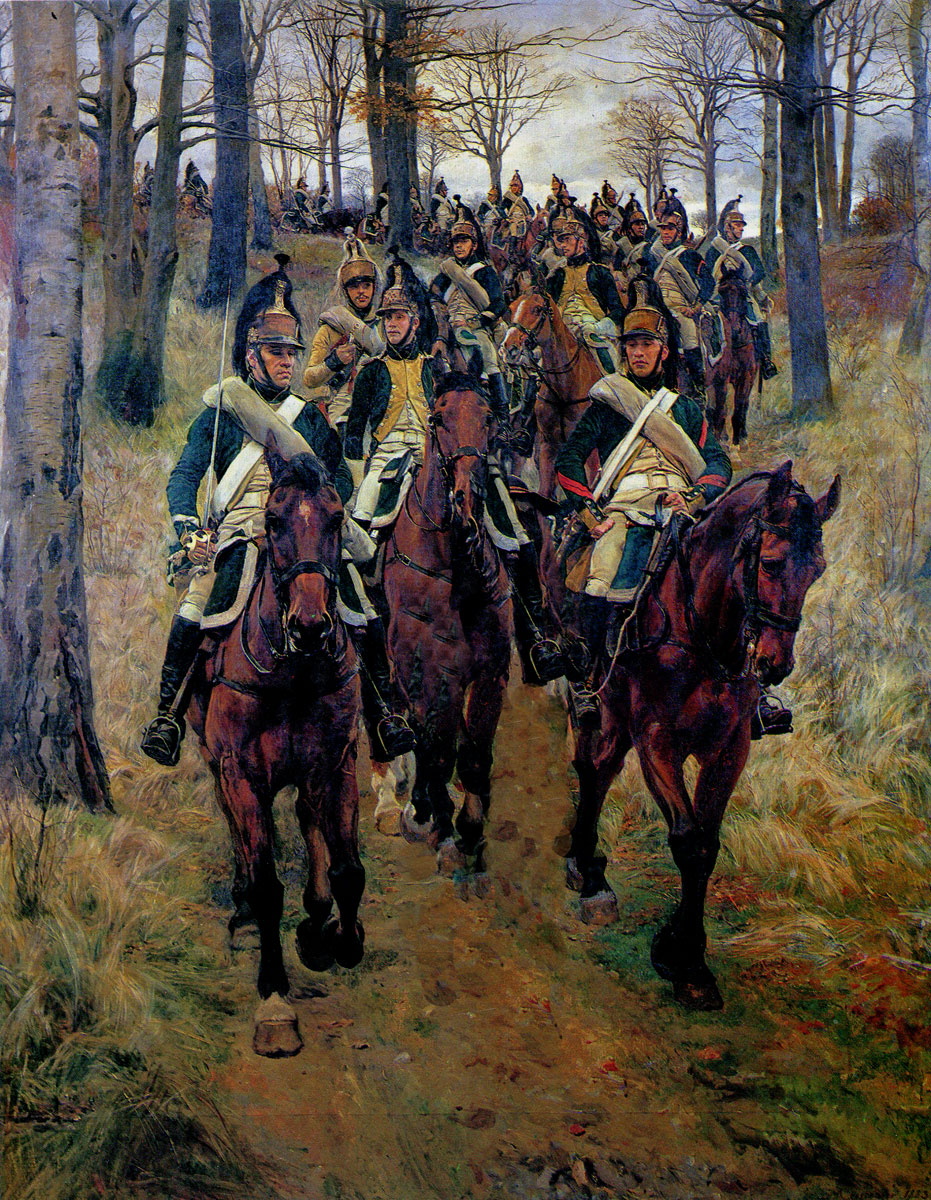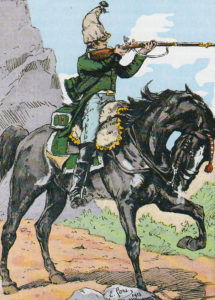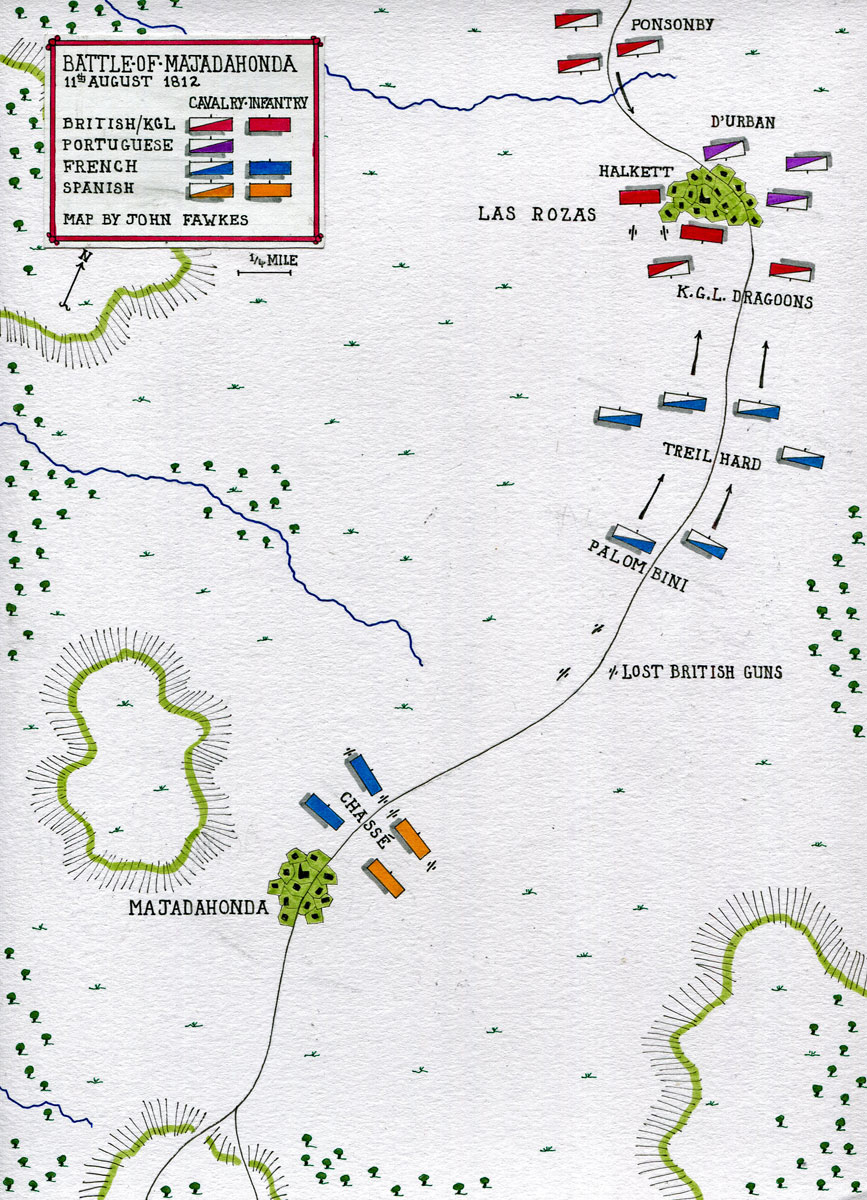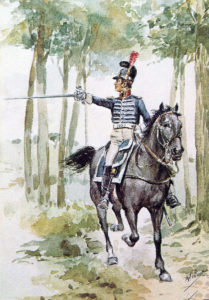The engagement on 11th August 1812 in the Peninsular War between Wellington’s advanced guard and Joseph Buonaparte’s cavalry rear-guard
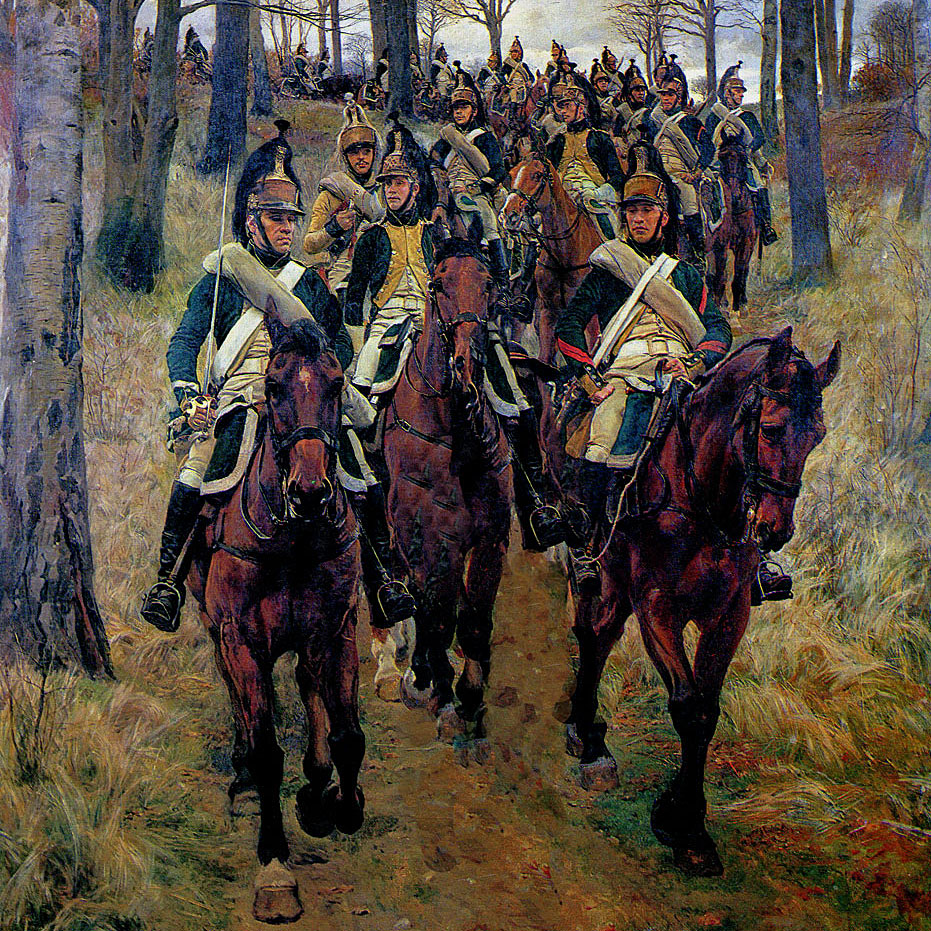 Podcast on the Battle of Majadahonda: the engagement on 11th August 1812 between Wellington’s advanced guard and Joseph Buonaparte’s cavalry rear-guard: John Mackenzie’s britishbattles.com podcasts
Podcast on the Battle of Majadahonda: the engagement on 11th August 1812 between Wellington’s advanced guard and Joseph Buonaparte’s cavalry rear-guard: John Mackenzie’s britishbattles.com podcasts
The previous battle of the Peninsular War is the Battle of Garcia Hernandez
The next battle of the Peninsular War is the Attack on Burgos
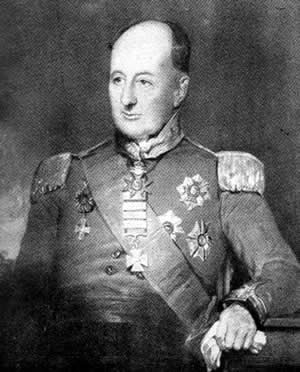
Colonel Benjamin D’Urban, commander of the Portuguese Dragoon Brigade at the Battle of Majadahonda on 11th August 1812 in the Peninsular War
Battle: Majadahonda
War: Peninsular War
Date of the Battle of Majadahonda: 11th August 1812
Place of the Battle of Majadahonda: in Spain, 5 miles to the north-west of Madrid
Combatants at the Battle of Majadahonda: British, Portuguese and King’s German Legion troops against the French
Commanders at the Battle of Majadahonda: Colonel D’Urban and Colonel de Joncquières commanded the Portuguese and King’s German Legion troops. General of Division Treilhard commanded the French troops.
Size of the armies at the Battle of Majadahonda: Treilhard’s French force numbered around 4,000 men. There were some 2,000 men in the Portuguese and KGL regiments attacked by the French.
Winner of the Battle of Majadahonda: The French attack was driven back, but achieved Joseph Buonparte’s aim of delaying Wellington’s advance, albeit briefly.
British, Portuguese and KGL regiments involved in the Battle of Majadahonda:
1st Brigade of the Cavalry Division, commanded by Major General Ponsonby: 5th Dragoon Guards, 3rdand 4th Dragoons
4th Brigade of the Cavalry Division, commanded by Colonel de Joncquières: 1st and 2nd Dragoons, King’s German Legion
Portuguese Cavalry Brigade, commanded by Brigadier General D’Urban: 1st, 11th and 12th Portuguese Dragoons
1st Brigade of the Seventh Division, commanded by Colonel Colin Halkett: 1st and 2nd Light Battalions, King’s German Legion, 7 companies of Brunswick Oels
French regiments involved in the Battle of Majadahonda:
Cavalry:
General Treilhard’s Cavalry Division: 13th, 18th, 19th and 22nd Dragoons.
Palombini’s Brigade of Italian Napoleone Dragoons and Wesphalian Chevaux Legers
Chassé’s Infantry Brigade comprising 2nd Nassau Infantry and the Spanish Regiment of La Mancha.
Background to the Battle of Majadahonda:
On 24th July 1812, Clausel brought the French Army of Portugal, battered from its heavy defeat at the Battle of Salamanca two days before, into Arevalo, a town 50 miles due east of Salamanca and 60 miles to the north-west of Madrid.
Joseph Buonaparte, Napoleon’s brother, appointed King of Spain by Napoleon, lay 10 miles to the south of Clausel with his army of 14,000 men. Joseph was still ignorant of the result of the Battle of Salamanca.
Clausel continued his retreat northwards, intent on evacuating the city of Valladolid of the French hospitals and supplies, before continuing north.
Joseph on hearing of the loss of the battle and that Clausel was moving north, hurried to return to Madrid.
Finding that Wellington was not immediately following him, Joseph took his army 20 miles east to Segovia.
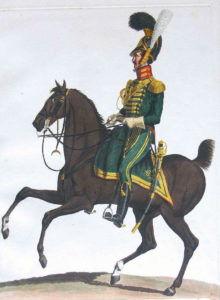
Westphalian Chevaux Legers of the French Army: Battle of Majadahonda on 11th August 1812 in the Peninsular War
Wellington delayed his pursuit of the French Army of Portugal, defeated on 23rd July 1812 at the Battle of Salamanca. His supply trains had been sent back to Ciudad Rodrigo before the battle.
Wellington feared that he could not rely on the discipline of his troops, unless they were fully supplied, compelling him to wait for the trains to return to the army.
Wellington resumed his pursuit of the French on 25th July 1812 and, on 30th July 1812, his army entered Valladolid, capturing 17 guns, 800 French wounded and sick in hospital and a large quantity of stores.
On 1st August 1812, Wellington moved his headquarters to Cuellar, before deciding whether to pursue Clausel to the north or Joseph to the south-east towards Madrid.
Clausel’s retreat north left a number of French garrisons exposed to capture; in Tordesillas, Zamora, Tora and Benavente.
Wellington ordered up a number of Portuguese and Spanish commanders to besiege and attack these posts.
Faced with the choice of pursuing Clausel north through Burgos or turning to the south-east and taking the capital Madrid from Joseph Buonaparte, Wellington decided to move on Madrid.
Anson’s light cavalry brigade and Clinton’s Sixth Division remained at Cuellar, while Wellington, on 6th August 1812, marched with his main army through Carbonero el Mayor, Segovia, San Ildefenso and into the passes of the Guadarrama Mountains, leading to the Spanish capital city of Madrid.
Account of the Battle of Majadahonda:
Faced by the impending arrival of Wellington’s substantially stronger army, Joseph Buonaparte hurriedly prepared to abandon Madrid and march east to Valencia on the east coast of Spain.
On 11th August 1812, Wellington’s advanced guard reached the village of Las Rozas, 10 miles from Madrid.
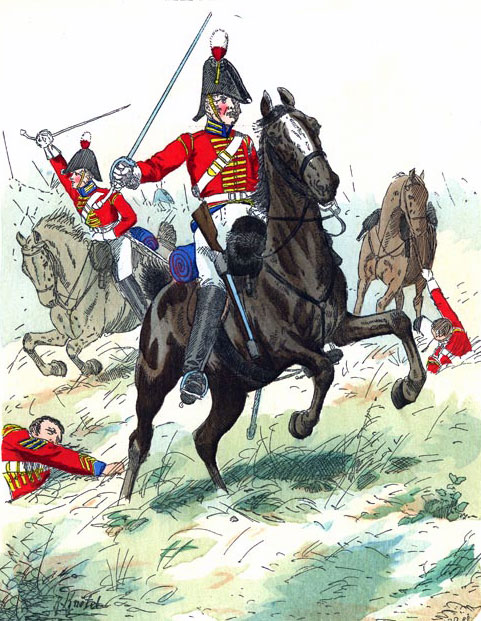
Dragoons of the King’s German Legion: Battle of Majadahonda on 11th August 1812 in the Peninsular War: picture by Richard Knötel
The troops that entered Las Rozas were the Brigade of Heavy Cavalry, comprising the 1st and 2nd Dragoons of the King’s German Legion and the 1st Light Battalion of the King’s German Legion, Macdonald’s troop of horse artillery with 6 guns and D’Urban’s Brigade of Portuguese Dragoons.
D’Urban’s brigade with 4 guns marched on a further 3 miles to the village of Majadahonda, while the KGL troops rested in Las Rozas.
A party of 20 KGL Dragoons rode in advance of the Portuguese Dragoons, keeping contact with the rear of the retreating French column.
Madrid was in turmoil at the imminent arrival of Wellington’s army, the French troops attempting to get away from the city with their baggage and guns; many of the Spanish residents, seen as traitors by the Spanish population, keen to escape with the French army, taking their belongings with them.
In order to gain more time for the evacuation of the capital, Joseph Buonaparte ordered General Treilhard, commanding the French Dragoon Division, to turn back, attack Wellington’s advanced guard and hold back his advance.
The troops made available to Treilhard were his own Division of French dragoons; the 13th, 18th, 19th and 22nd Dragoons, Palombini’s Brigade of Italian Cavalry comprising the Italian Napoleone Dragoons and Wesphalian Chevaux Legers and 4 guns.
Chassé’s infantry brigade, comprising 2nd Nassau Infantry and the Spanish Regiment of La Mancha, supported Treilhard.
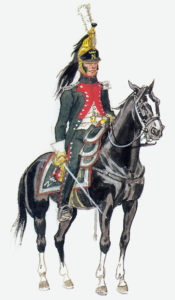
Italian Napoleone Dragoon of the French Army: Battle of Majadahonda on 11th August 1812 in the Peninsular War
D’Urban’s Brigade of Portuguese Dragoons was emerging from the southern end of the village of Majadahonda, on the Madrid road, when they met the 20 KGL Dragoons hurrying back from their position to the front, reporting that a strong body of French cavalry was behind them.
D’Urban continued with his advance and encountered a couple of squadrons of French dragoons, inferior in numbers to his brigade, advancing towards him.
D’Urban advanced to attack the French squadrons, bringing his 4 guns forward.
It quickly became apparent that the French squadrons were part of a substantial force. Behind them appeared the rest of Treilhard’s dragoon division and the regiments of Palombini’s Brigade.
D’Urban’s 3 regiments of Portuguese Dragoons had little prospect of successfully engaging such a powerful French force and they wheeled about and made off in the direction they had come, pursued by the French cavalry.
Of Macdonald’s 4 guns, 1 got away, but the others were overturned or damaged in the pursuit and captured.
The French dragoons rode on to Las Rozas, on the heels of the Portuguese and caught the 2 KGL Dragoon regiments unprepared, many of the troopers watering their unsaddled horses.
Warned by the Portuguese of the impending attack by the French, 2 companies of the KGL 1st Light Infantry Battalion with some dismounted soldiers from the KGL Dragoons took up positions at the entrance to Las Rozas and held off the French Dragoons, while the rest of the KGL regiments, infantry and cavalry, formed up in the market square.
Together with the Portuguese Dragoons, the KGL Dragoon Regiments attacked and drove the French cavalry back to Majadahonda.
Here the French cavalry were supported by Chassé’s infantry and the 3 French guns.
Again, the Portuguese fell back, leaving the KGL Dragoons to be driven back to Las Rozas.
The KGL 1st Light Infantry Battalion was positioned in houses on the edge of Las Rozas, from where they opened a damaging fire on the approaching French cavalry and the KGL Dragoons, taking advantage of the halt imposed on the French Dragoons by the KGL Light Infantry, reformed and delivered a damaging charge.
Ponsonby’s British Heavy Cavalry Brigade, comprising 5th Dragoon Guards, 3rdand 4th Dragoons, was approaching down the road with more battalions of KGL light troops.
Treilhard drew his men off, leaving the captured British guns and bringing the battle to a close.
Casualties at the Battle of Majadahonda:
The British, KGL and Portuguese regiments suffered 53 killed, 98 wounded, 45 captured and 81 horses lost.
Among the officers, the KGL Dragoon Brigade commander, de Joncquières, was captured.
The French officer casualties were 1 killed and 15 wounded. It seems likely that the level of casualties among the non-commissioned ranks was similar to the Portuguese and KGL.
Follow-up to the Battle of Majadahonda:
Following the Battle of Majadahonda, Joseph Buonaparte left Madrid with his French army, heading east towards Valencia, accompanied by those Spanish committed too heavily to the French regime to remain without French protection.
The French were without adequate supplies, forcing them to pillage the countryside through which they passed. The marauding French troops were slaughtered by the Spanish guerrillas. The Spanish troops in Joseph’s army deserted almost to a man.
Wellington and his British, Portuguese and Spanish army entered Madrid on 12th August 1812, to the delight of the city’s remaining populace.
Battle Honours and Medal for the Battle of Majadahonda:
The Battle of Majadahonda was not a clasp on the Military General Service Medal 1848 nor a British battle honour.
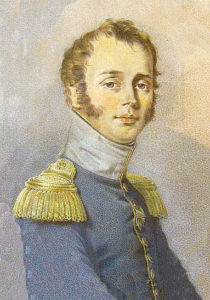
Colonel Vicomte Marie-Antoine Reiset, colonel of the French 13th Dragoons at the Battle of Majadahonda on 11th August 1812 in the Peninsular War
Anecdotes and traditions from the Battle of Majadahonda:
- After the Battle of Majadahonda, the Portuguese dragoons of D’Urban’s brigade were heavily criticised for giving way twice during the battle. Marshal Beresford, the British officer commanding the Portuguese army, proposed that the Portuguese dragoons be dismounted and required to lead their horses until they re-established their good name. Wellington rejected the proposal. He did not have enough cavalry to limit the dragoons in this way.
- Vicomte Marie-Antoine Reiset, colonel of the French 13th Dragoons, commanded one of Treilhard’s brigades at the Battle of Majadahonda. Reiset distinguished himself at the Battle of Jena in 1806 by capturing Prince Augustus of Prussia.
- Fortescue comments: ‘One point of interest in the action is that it went near to destroy the reputation of Wellington as a commander who had never lost a gun.’
References for the Battle of Majadahonda:
See the extensive list of references given at the end of the Peninsular War Index.
The previous battle of the Peninsular War is the Battle of Garcia Hernandez
The next battle of the Peninsular War is the Attack on Burgos
Podcast on the Battle of Majadahonda: the engagement on 11th August 1812 between Wellington’s advanced guard and Joseph Buonaparte’s cavalry rear-guard: John Mackenzie’s britishbattles.com podcasts
